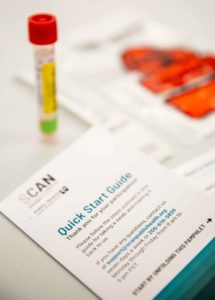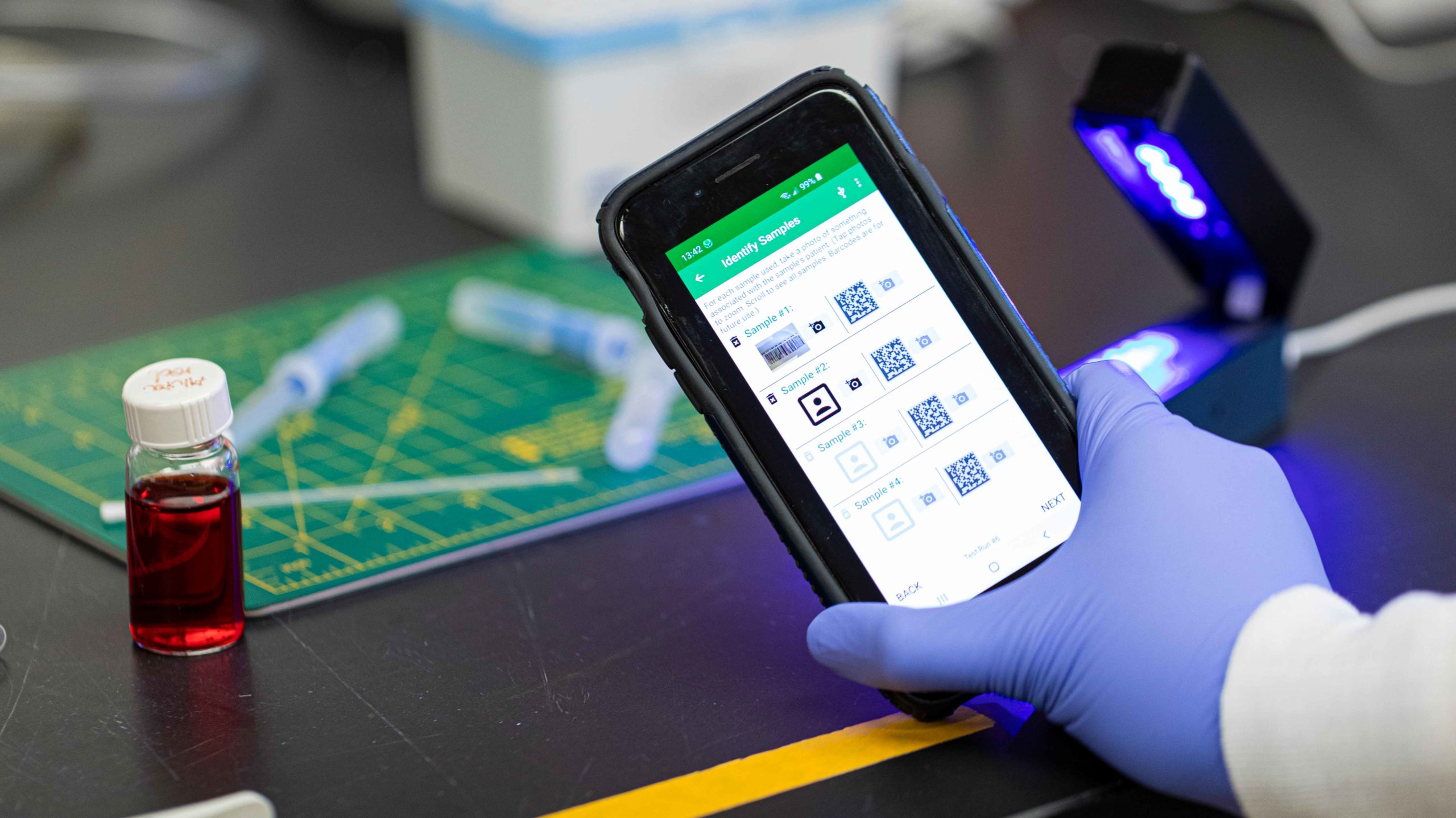Photos by Dennis Wise and Mark Stone/UW Photography
Barry Lutz, associate professor, and his lab are working on multiple fronts to support the need for coronavirus testing.
From flu to COVID-19

Barry Lutz
Dr. Lutz’s group, in partnership with Dr. Matthew Thompson, UW professor of family medicine and global health, has been working to develop home-based testing for the pandemic response as part of the multi-institution Seattle Flu Study (SFS). When COVID-19 arrived in Seattle, SFS pivoted to become the Seattle Coronavirus Assessment Network (SCAN) to officially serve the Public Health – Seattle & King County coronavirus response. Last year, as part of the SFS the Lutz -Thompson team conducted a study mailing flu test kits to people who volunteered to swab their noses and run the tests at home to help track the spread of flu. “Because of that experience with home test kit design and mailing logistics, we became the swab kit assemblers for SCAN, and we have a swab kit mailer ‘factory’ in NanoES,” Dr. Lutz said. Powered mainly by a student crew including BioE undergraduates with SFS/SCAN supervisors from the Lutz-Thompson team, the assembly takes place at the UW Institute for Nano-engineered Systems, or NanoES, Building on campus.

UW Bioengineering student Kara DeLeon, above, is part of the team assembling COVID-19 test kits. Because the home-testing team had refined their flu kit fabrication and shipping logistics processes, they were able to quickly pivot to rebrand their test kits in partnership with Seattle and King County, and adjust shipping procedures to ensure test kits were available to a diverse population in King County.
Within about eight days, the team shifted from assembling flu kit supplies and information to those tailored to coronavirus, says research scientist and lab supervisor Jack Henry Kotnik, part of Dr. Lutz’s and Dr. Thompson’s labs. “It was a huge collaborative effort to pivot to COVID-19 testing,” Kotnik says. “To produce the number of kits that we did required coordinating between study arms to source materials, troubleshoot the shortages for testing components that the rest of the world was also facing, and muster a workforce capable of a quick transition.” With the help of students and key leadership Rachel Geyer and Victoria Lyon, both research scientists in the Thompson lab, they produced nearly 8,000 SCAN kits in the first week and a half after confirmation that they were pivoting. To date, Kotnik estimates they have assembled more than 15,000 kits, the majority of which have shipped out to people throughout King County.

The UW SCAN home-testing study team pulled together components such as transport media and sample bags, and created a new quick-start instruction card in multiple languages.
The Lutz-Thompson team is also applying other concepts they developed for the Seattle Flu Study to COVID-19. They are working to develop symptom-based predictions of COVID-19, the illness caused by the new coronavirus, and to design at-home studies that will evaluate coronavirus self-tests as companies develop them.
Symptom-based predictions can inform a diagnosis, and accurate predictions could be used for tracing and tracking outbreaks, or to create a “symptom checker”-type app that could be filled out at a doctor’s office or screening point at the airport. “We’re interested in diagnosing individuals on the spot,” says Dr. Lutz.
They’re currently reviewing all symptom reports in the literature to see if any consensus emerges to help develop predictions. In the future, they plan to also search medical records and survey the public, as they have done for flu prediction studies.
The team is also working on ways to evaluate the home tests that companies are rapidly developing. They want to determine how accurate and usable the tests are in real-life conditions, when untrained people take a sample, run the test and interpret the results, all at home.
Lutz lab develops rapid community and at-home tests
In a separate project, the Lutz research group is developing tests for the novel coronavirus, officially called SARS-CoV-2, that would enable minimally-trained staff or untrained users at home to diagnose COVID-19. The tests are based on a simple device and chemistry that his lab had been developing for the past year to diagnose flu and HIV from a nasal swab.

Enos Kline, research scientist in the Lutz lab, designed a test to detect RNA from the new coronavirus within a week after the first case appeared in Washington state.
Early in the crisis – January 22, one day after the first case appeared in the Seattle area – Enos Kline, research scientist, and his coworkers in the Lutz lab jumped into action. In about a week, Kline designed an RNA amplification assay to detect the known sequence of SARS-CoV-2, and other lab members stepped up to help develop it into a complete system, including a sampler, ready-to-use assay chemistry, and a detector controlled by a phone app. By mid-February, they had a prototype device for $200 that detects SARS-CoV-2 RNA in under 45 minutes with sensitivity near laboratory tests approved by the U.S. Food and Drug Administration (FDA). “It has been amazing to watch,” Dr. Lutz says. “This was an organic development by volunteers, and it happened very fast.”
Since then, the researchers have been working to find a way to scale up their system quickly through contract manufacturing. The lab’s goal by fall is to complete FDA emergency use authorization (EUA) for a device that aligns with the U.S. goal of millions of accurate and easy-to-use tests each week. The group’s approach is to try to make the cost of each individual test as low as possible, Dr. Lutz says, to test many people at small clinics, schools, workplaces, and community sites, and potentially so people could test daily at home. “We’re focused on a very low cost per test with lab quality and quick turn-around,” says Dr. Lutz.

The Lutz lab’s coronavirus test includes a detector device controlled by a smartphone app.
In early February, the Lutz lab members looked at what they had and thought, “We could have an impact on the COVID pandemic,” Dr. Lutz recalls. But to make an impact they need two things: FDA authorization and the ability to make enough tests to make a difference. “The urgency makes it cut and dried. It’s a harsh way to put it, but right now our test is worthless – we will have no impact unless we reach those two goals.”
For now, the team is working hard and has found a collaborator who can help. The lab has applied for grants to support the needed speed of development and scale-up, and they have partnered with a company that develops diagnostics for public health to work towards production and FDA authorization.
“We are continuing to make improvements at the bootstrapping level, but what we really need is big funding to move fast and scale up production big time.”
Lutz Lab COVID-19 Test Contributors
- Enos Kline, research scientist (instigator, assay design)
- Nuttada Panpradist, BioE Ph.D. student (ready-to-use reagents)
- Mike Roller, research engineer (detector design)
- Bob Atkinson, BioE Ph.D. student (app & software)
- Qin Wang, BioE Ph.D. student (protein production)
- Ian Hull, BioE Ph.D. student (protein production)
- Daniel Leon, research scientist (housing design)
- Jack Henry Kotnik, research scientist (FDA guidance)
Read about more coronavirus-related projects in the UW Bioengineering department.
Article by Lia Unrau



